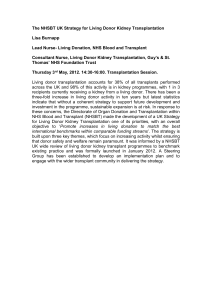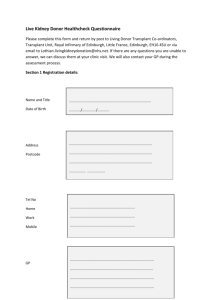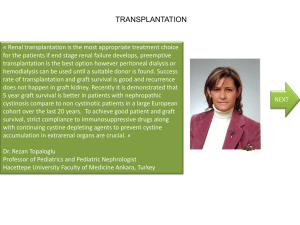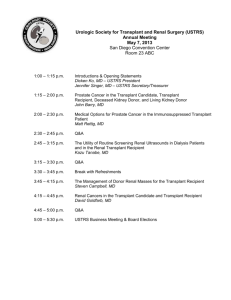Specialised Commissioning of Kidney Transplantation
advertisement
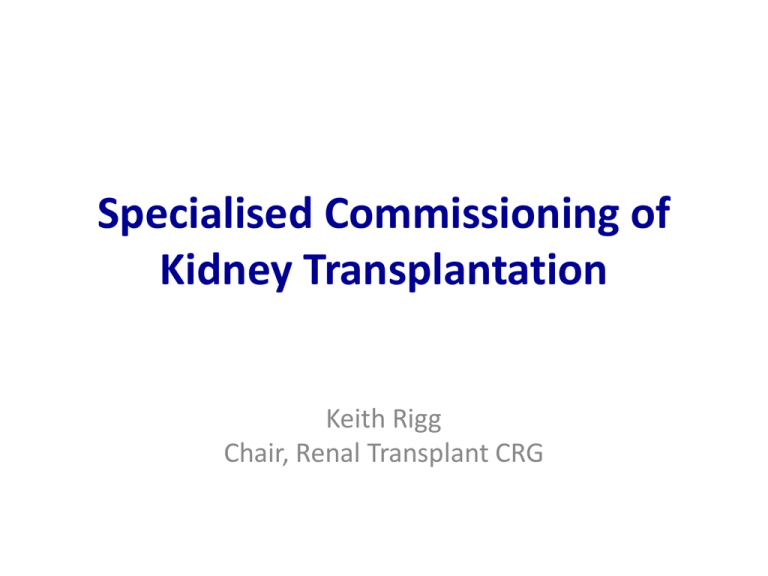
Specialised Commissioning of Kidney Transplantation Keith Rigg Chair, Renal Transplant CRG 1. Introduction 2. What has been done? 3. What is coming? 1. Introduction Specialised Commissioning • Where does it fit into NHS England? – Alongside commissioning of primary care, offender healthcare and aspects of armed forces healthcare • What is included? – Prescribed services meeting defined criteria • Budget of £13.8 billion pa (14% NHS budget) • Six national Programmes of Care Operating model for specialist commissioning • Single ‘do once’ function at national level • Strategic interpretation at a regional level • Provider/commissioning interface at Area Team level Where do the Clinical Reference Groups (CRGs) fit in? Roles of CRG • Specialised advice and guidance • Developing national service level strategy • Developing and providing assurance of commissioning products • Evolving performance management role Specialised Commissioning Taskforce • Established April 2014 • Improve how NHSE commissions specialised services and to put commissioning arrangements on a stronger long term footing • Seven work streams • Priorities – Deliver balanced financial plan – Reducing unwarranted variation & improving quality – Strengthening commissioning infrastructure 2. What has been done? What has been done? • • • • • • • Service specification Commissioning policies CQUIN Quality measures and dashboard 5 year strategy Collaborative working Business as usual Service Specifications • Clear description of what a service is and the acceptable standards that need to be in place for delivery • Benefits of country wide single service specification • Recognise different ways of service delivery and interface with RDI CRG • Concentrate on the ‘what’ not the ‘how’ Commissioning Policies Current • Reimbursement of expenses for living kidney donors Consulting • Eculizumab for the treatment of refractory antibody mediated rejection post kidney transplant • Bortezomib for the treatment of refractory antibody mediated rejection post kidney transplant CQUINs 2013/14 • Cold ischaemia time – DCD <12 hours – DBD <18 hours • Increase use of Renal Patient View Quality Measures • NHS England/NHSBT agreement • Kidney Centre Specific reports – Robust data – Validated by centres – Available to units, commissioners, patients • Purpose to reduce unwarranted variation and improve quality RTR Dashboard • Access to renal transplant – Median waiting time – DBD Organ Decline rates – standard & extended – % of living donor transplants that are pre-emptive • Transplant outcomes – 1 & 5 year graft and patient survival rates for deceased and living donor transplantation Five Year Strategy • Improving the deceased donor transplant patient pathway - from assessment to transplantation • Living Donor Kidney Transplantation • Improving the deceased donor transplant patient pathway - from assessment to transplantation • Improving the effectiveness of kidney transplant follow-up Collaborative Working • Renal Dialysis CRG • NHS England/NHSBT • National Services Division, Scotland Business as Usual • Advice and Guidance – Local Area Teams – Clinicians – Patient Groups – IFRs – Drug issues • NICE stakeholder • Performance management 3. What is coming? What is coming? • • • • • National Tariff QIPP Future commissioning models Peer Review Managing capacity What is the Renal Transplant Currency? Different ways of working • • • • • Work-up – what, who, where? Maintenance on list – what, who, where? Transplant procedure Follow-up – what, who, where? Repatriation – who, when, where? Need a single model of currency and costing that will capture different ways of working Currency development • Workshop January 2013 • Mandated currency from April 2013 • Four pilot networks – Effectiveness of recording currencies – Case mix audit undertaken – variation in investigations and frequency • Workshop October 2013 – Currencies best recorded through adapted clinic outcome form – Broad agreement reached on pathway in terms of currency and tariffs to be utilised Next Steps • Initial finance workshop June 2014 • Costings being modelled to currencies • Shadow tariff 2015/16 • National tariff 2016/17 QIPP 2013/14 • Immunosuppression prescribing – Secondary care prescribing & Homecare delivery – National Procurement – Push towards increased used of generic brands • Pre-emptive living donor transplantation – Linked to NHSBT LDKT strategy QIPP 2015/16 • Clinically led QIPP programme to produce 3% savings - £420 million • CRGs working with area teams • Dilemma for transplantation – increased activity vs savings – Increasing transplantation – Reducing unwarranted variation Future Commissioning Models • National specialised commissioning • Co-commissioning with CCGs • Commissioning by CCGs Peer Review Key aims • Quality assurance of a service • Enable quality improvement of a service Why consider peer review? Benefits Disbenefits • Recognise and share good practice • Identify and act on reasons for nonstandard variation • Increase public and commissioner confidence • Increased regulatory burden • Negative perception • Time and resource required Activity and Capacity • 2007/08-2013/14: 47% increase in the number of new transplants performed per year • 2008-2013: 31% and 40% increase in the number of functioning transplants in transplant centres and specialist renal centres respectively

